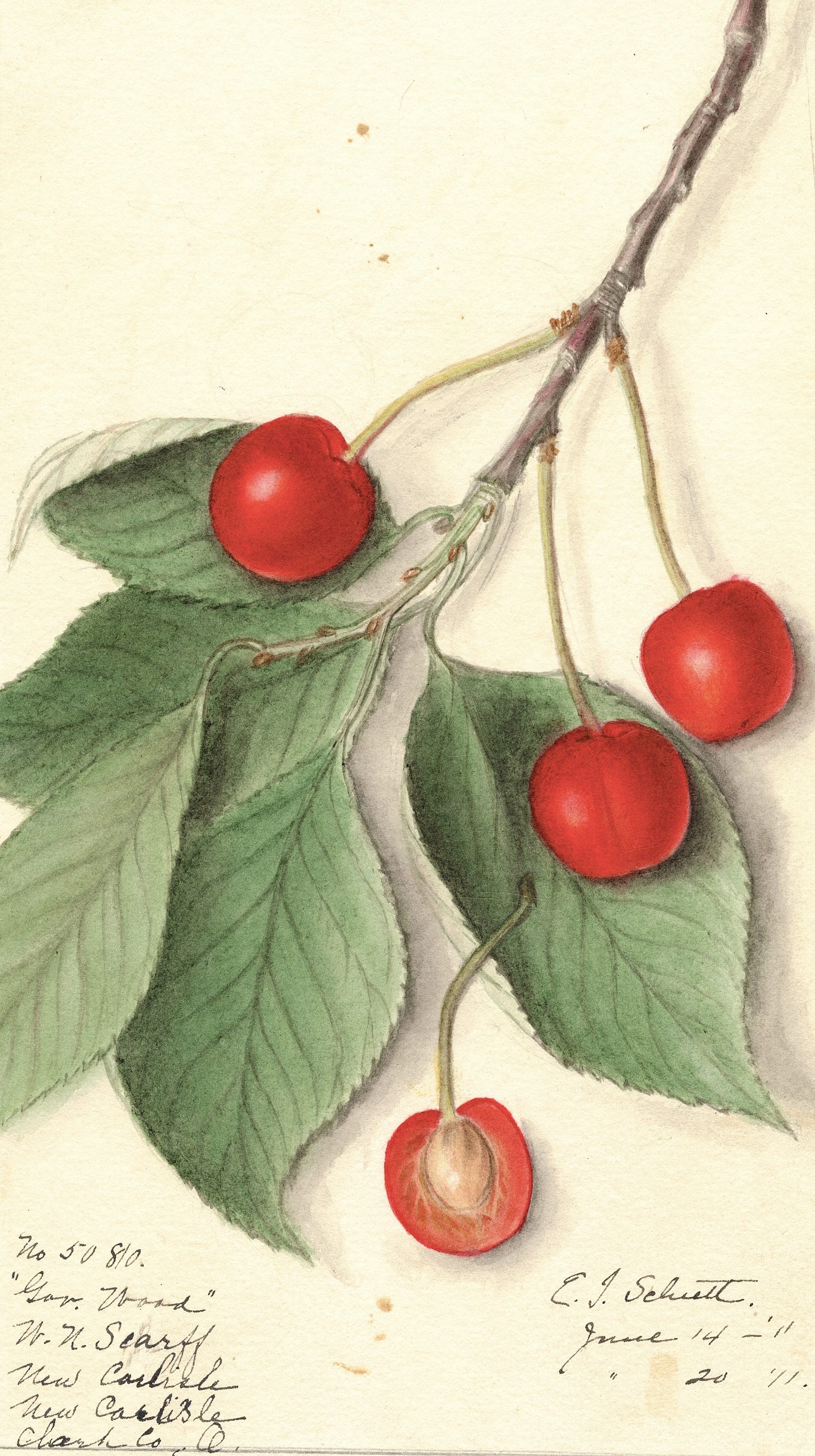Governor Wood
The Governor Wood Cherry was the first commercially successful American-bred cherry, and one of four cherry varieties created by America’s foremost cherry breeder of the first half of the nineteenth century, Dr. Jared P Kirtland (1793-1877). The other of his cherries were the Rockport, the Red Jacket, and the Mary Kirtland.
Only a very few individual breeders successfully plotted crosses among established varieties of cherry producing hybrids with qualities that captivated nurserymen, growers, and consumers. Thomas Knight of the London Horticultural Society was perhaps the greatest of the first quarter of the nineteenth century. During the second quarter of the century, Dr. Jared P. Kirtland of Cleveland, Ohio, was the greatest cherry breeder in the western hemisphere and a horticulturist of singular merit, breeding peonies, inventing a method of grafting magnolias, and breeding grapes, raspberries, and pears as well as cherries. Governor Wood, an 1842 creation named in honor of Govenor Rueben Wood of Ohio, was the most popular of his many creations, an early season sweet cherry of sumptuous flavor. [The Cherries of New York, 200.]
Kirtland was as close to a scientific breed as one got in 1840s America. A Connecticut native, he attended Yale and received his medical education with Dr. Benjamin Rush in Philadelphia. His father, Turhad Kirtland, was an agent of the Connecticut Land Company that held tracts in the Western Reserve, and so the young Jared P. carted to his books to Ohio to join his parent in the development of the region. He lived in Poland sometime in the later 1820s, traveling on horseback to treat the scattered settlers of that region. While on these travels he botanized, collecting specimens of flora and fauna, and made a particular study of fresh water mollusks. His reports on the structure mollusk shells won him a national reputation and corresponding membership in the Boston Society of Natural History. In 1838 Ohio appointed Kirtland as head of the natural history portion of a geological survey of the state. He left off medical practice, moved to Cleveland, and accepted an appointment as professor at Cleveland Medical College. It was during the period 1838 to 1858, while living in Cleveland, that Kirtland bred his cherries, pears, and flowers. He corresponded internationally with pomologists, collecting different varieties of fruit trees, examining seedlings in his orchards and developing the most promising of them into named varieties. The Governor Wood was one such exceptional seedling, probably a cross between a Yellow Bigarreau and a White Heart or perhaps an Elton Cherry.
Because the flesh of the Governor Wood was soft, rather than firm, and because there was a tendency for the fruit to crack under wet conditions, the cherry from the first was promoted by nurseries for home orchards rather than commercial producers of fruit. The Governor Wood would not withstand the rough handling entailed in shipping. The Kentucky Nursery epitomized the cherry’s qualities thusly: “The finest of Dr. Kirtland’s seedlings; clear, light red; tender and delicious. Tree vigorous and product. Hangs well on the tree. End of June” (Catalogue 1897, 21). The variety remains available from commercial nurseries in the United States. The USDA register: http://www.ars-grin.gov/cgi-bin/npgs/acc/display.pl?1564344 .
The Governor Wood described: "Fruit, large, roundish, heart shape; color, rich light yellow, mottled or marbled with a beautiful carmine blush, and when grown fully exposed to the sun it becomes a clear red; suture, half round, followed on the opposite side by a dark line; flesh, light pale yellow, half tender, juicy, sweet, with a rich, high flavor; season, middle of June. "Tree, a vigorous, healthy, strong grower, forming a round regular head, very productive; flowers large; foliage abundant." In an early volume of The Horticulturist, notice was made of it by Mr. Barry, the Editor, as follows: "In beauty of appearance, and delicacy and richness of flavor, we have seen none that equals the Governor Wood. We have had it in bearing some four or five seasons, and it has been uniformly fine: so it has proved in other places, as far as our knowledge extends. We said, the first year it bore, that it was one of the finest table fruits we ever saw, and to-day we consider it as having no superior. It will not be.so popular in the market as the Black Tartarian, Yellow Spanish, Napoleon, or some others, but every amateur will desire to have it in his collection. Flesh is tender, like Downer's Late, and others of that class, juicy, sweet and fine flavored. The tree is an erect, handsome regular grower, hardy and very productive, the branches being literally covered with fruit, as though they were tied on; the fruit, we think too, is the least liable to rot, and hangs longest sound on the tree of any variety we know ripening at the same time." "The Govenor Wood Cherry," The Horticulturist, and Journal of Rural Art and Rural Taste (January 1870), 40.
Illustration: E. J. Shutt, USDA Pomological Watercolor Collection, Beltsville Maryland. Public Domain Image.





